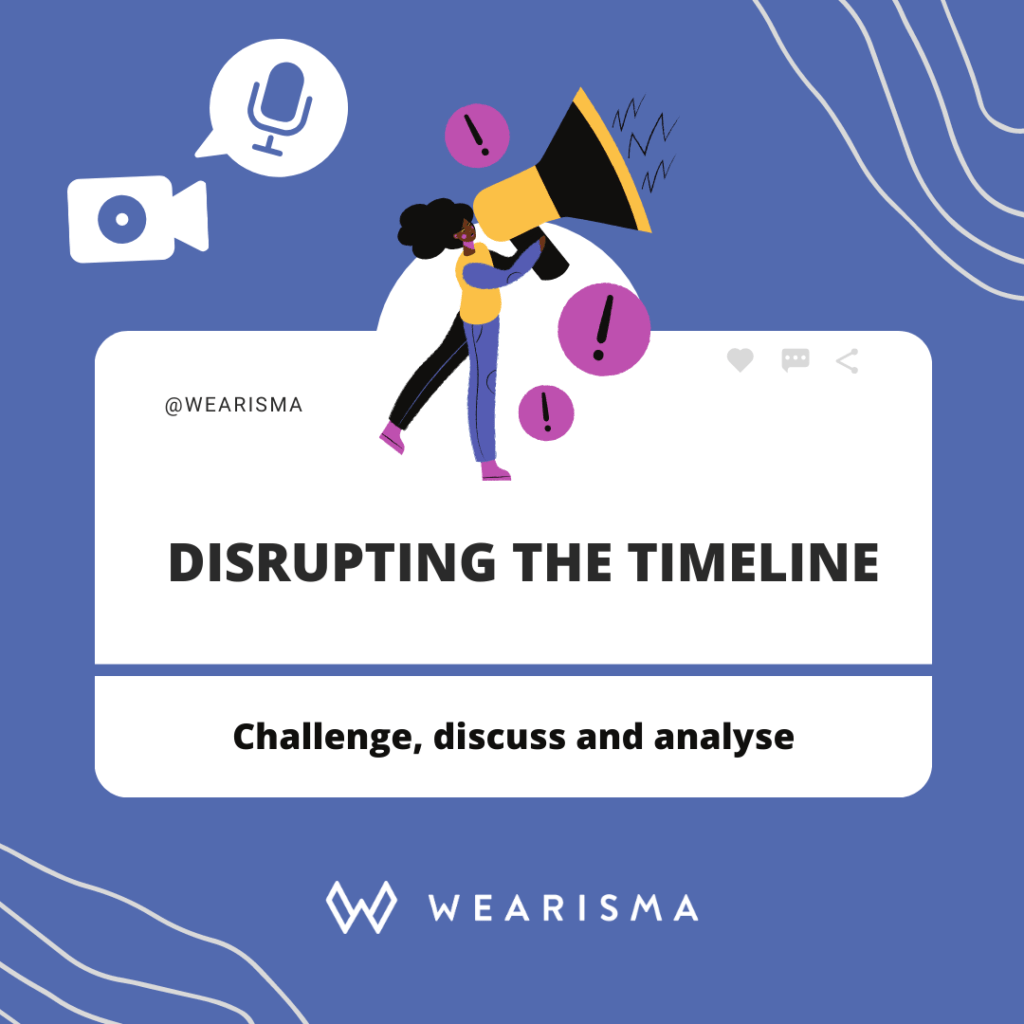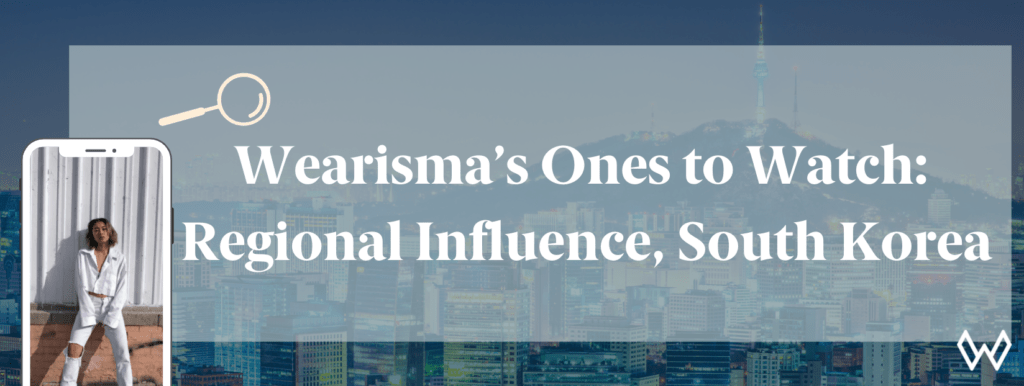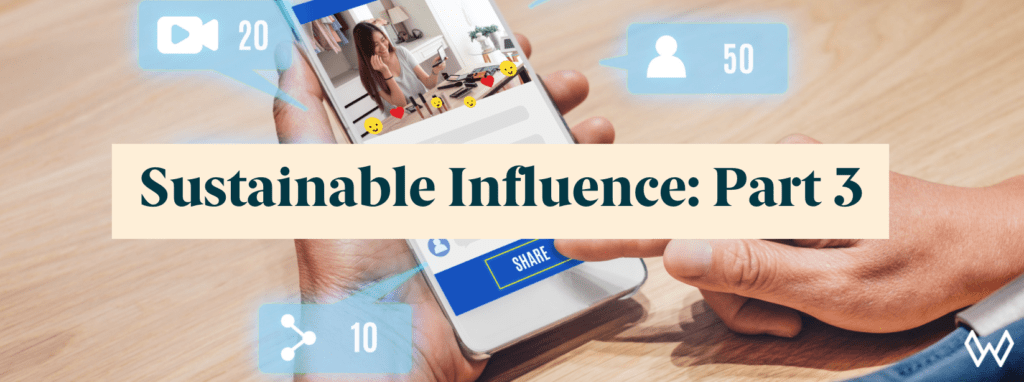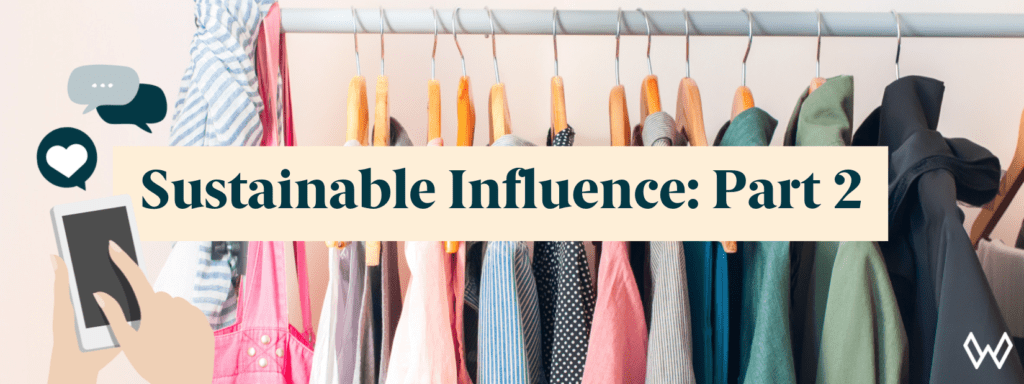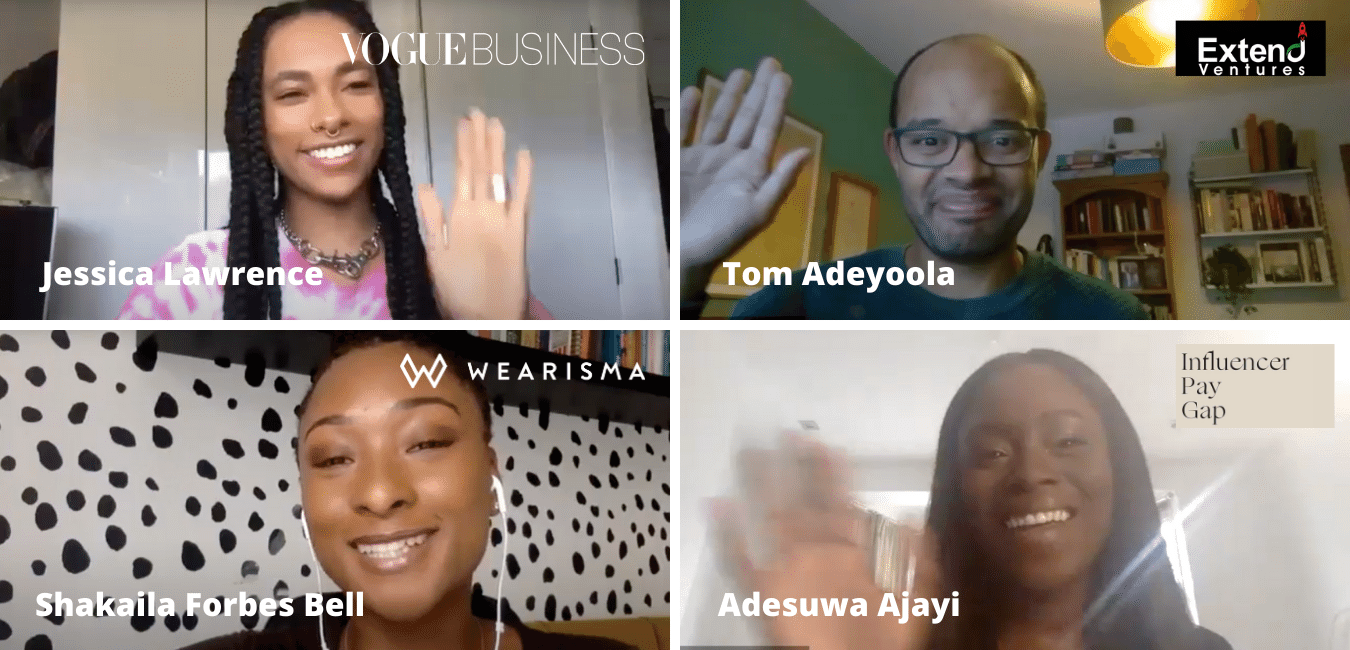
Wearisma Launches ‘Disrupting the Timeline’ Video Podcast
We’re excited to announce the launch of our new video podcast series ‘Disrupting the Timeline’
Every month we’ll be joined by a series of industry experts where we discuss how to cut through the noise, generate meaningful impact, and cultivate engaged online communities. Marketing is changing faster than ever. Join us in disrupting the timeline to create real dialogues and build brand advocacy online!
In our first episode ‘Mapping out the future of diversity and inclusion’, Wearisma’s Marketing Manager Shakaila Forbes-Bell is joined by a series of stellar guest speakers: Tom Adeyoola, Co-Founder at Extend Ventures, Adesuwa Ajayi, Founder of Influencer Pay Gap and Jessica Lawrence Social Media and Communities Manager at Vogue Business.
Key topics discussed:
- What role should technology and social media play in diversity and inclusion initiatives
- How can we tackle racial discrimination in the influencer marketing industry
- How brands can progress beyond performative allyship and more…
We gave you a rundown of the highlights below but make sure you check out the full video on our Youtube Channel or listen in via Spotify or Soundcloud.
This summer the second iteration of the Black Lives Matter movement renewed conversations about the treatment of ethnic minorities across all walks of life. In ‘How Black Lives Matter Moved Beyond a Hashtag’ we highlighted the driving force of social media communities to provoke global change and make significant strides towards true diversity and inclusion but much more work is to be done.
On this episode, Tom Adeyoola discusses the drastic way conversations around diversity and inclusions have changed this year. During his tenure at Metail, he reveals how brands have baulked at data which highlights growing consumer interest in ethnically diverse models and discusses the role technology plays in pushing this movement forward. Tom also gives us an insight into the work Extend Ventures is doing to support Black and ethnic minority Businesses.
The way brands communicate with their audiences has changed forever and on this episode, Jessica Lawrence provides key advice as to how brands can avoid being #cancelled and become true allies. She goes on to explain that the appetite for content that promotes diversity and inclusion is on the rise.
Adesuwa Ajyai founder of Influencer Pay Gap gives us a keen insight into the issue of pay disparities between influencers of colour and white influencers. She discusses the changes her platform has brought about and what brands are doing to foster equality in their influencer initiatives. Check out the highlights from this insightful conversation below.
“Once you take away all the elements of the economic system, commerce, shopping, travel, what was underlying and exposed was the skeleton and how unequal it really was”
Tom Adeyoola
Shakaila: Thank you all for joining me today. I’m super excited to get stuck into this conversation. I’m going to start with you, Tom. And kick this off by talking about the events of this summer, where we saw the powerful second iteration of the #blacklivesmatter movement. What do you think is so different about this iteration? And how do you think it’s progressed since its inception in 2013?
Tom: I think, ultimately, it was a lot of perfect things coming together being able to create that perfect storm to create a global debate on the issue. When Black Lives Matter came around once before it didn’t really get that traction but since then people have realized that you can’t outsource all of your values and issues to the government. The government isn’t going to do it. We the people must generate change. After the deaths that were happening in progressive order Breeona Taylor, Ahmaud Arbery, and then George Floyd at the same time, whilst the general public were all under lockdown, and once you take away all the elements of the economic system, commerce, shopping, travel, what was underlying and exposed was the skeleton and how unequal it really was. So that the inequity of the global system, the social system, and the economic system has just been something that I think everybody’s been thinking about. I think that’s why in this movement, it wasn’t just a case of Black people and protesting it felt more like everybody was involved.
Shakaila: Jess, we all saw the wave of black squares at the height of the Black Lives Matter movement, the second iteration, how have brands progressed beyond performative activism?
Jess: I think some brands have definitely progressed beyond this performative allyship, or performative social media presence in supporting Black Lives Matter by actually pledging and showing some accountability, which I’ve never seen before in my life on social media. For example, the 15 per cent pledge, which aims to support Black businesses. I think what’s super important is that brands continue to do this and not be bogged down by how long it takes or the conversations that are uncomfortable, but actually looking into their hiring, looking into their teams, looking into how they can do better, and actually putting their hands up being accountable for where they’ve been lacking previously. I think what’s been great about this movement, for me personally, is that there’s accountability. No one’s expecting everyone to be perfect from the get-go now, it’s really showing that the steps that you take from here on out are the most important.
“Information is power. If you don’t have the information, you can’t improve anything, so you can’t improve what you don’t measure.”
Tom Adeyoola
Shakaila: Coming to you Adesuwa, can you tell us a bit more about Influencer Pay Gap and what motivates you, and what motivated you to start it in the first place?
Adesuwa: The influencer of pay-gap started to be honest out of frustration Being in the
space for a while it’s not unknown that Black creators, influencers, across the creative industry definitely deal with a unique type of experience. I started to notice, say for example, if you’re a black influencer, and you didn’t necessarily have a network of other influencers to rely on and speak about things such as pay, you kind of wing it. There needed to be a space where they were able to see what other people were earning across a variety of demographics, specifically, Caucasian individuals and what they’re earning to understand how a brand works with people across all these different demographics. It’s so easy for things such as exploitation and pay discrimination to continue because people aren’t able to compare amongst other people in the space.
Some people experience mistreatment in the influencer industry because it’s generally unregulated. Brands and agencies have been able to get away with completely low balling influencers simply because no one’s keeping an eye on what they’re doing. So, I think there’s the whole issue of the industry not having as many protective measures to protect influencers as they navigate the space. The page has definitely drawn light to that and I’ve created a way whereby people are able to speak a lot more openly without being blackballed.
Shakaila: What response have you gotten from brands in regards to influence a pay gap?
Adesuwa: It’s a mixed bag, of course, and it has definitely been disruptive in a sense. When each day passes and you see the discussions on the page you realize that to some brands, it is seen as a level of accountability that they might not necessarily be prepared for. It takes the control out of the brand side and puts it in the hands of influencers.
From the brand side, we’ve had brands that have reached out and actually wanted to solve the issue. We’ve had a brand that wanted to get in contact with an influencer who wrote in and with their permission I bridged that relationship. After the discussion it was revealed that the influencer was low balled significantly, she was offered just £100 and she had over 600K followers. That brand then ceased working with the agency that initially approached the influencer stating the approach is not something they stand by. It’s also an acceptance that there are so many players in it as well. Sometimes it might be the brand directly. Sometimes it might be that they’ve outsourced something to an agency, and the agency hasn’t necessarily handled it in the right way. Even with brands that haven’t necessarily been pleased that they’ve been featured on the page, you do see that they have implemented some kind of change. I think brands now understand the issue and are asking themselves so what do we do now? How do we implement the necessary change?
“No one’s expecting everyone to be perfect from the get-go now, it’s really showing that the steps that you take from here on out are the most important.”
Jessica Lawrence
Shakaila: Coming over to you, Tom. During your time at Metail, can you tell us a bit about instances of when tech and data were used to support diversity and inclusion and how these actions were received?
Tom: One of the things that we were focused on at Metail was around the diversity of body image and helping the consumer be able to basically try clothes on their actual self. So a key aspect of that was the ability to see clothes on and move away from the projected ideal of the model that you see on standard clothing shots – the aspirational form that’s out of most of our reach. That was a key focus for us. It was interesting when we would go into meetings with brands and have conversations around the ability for them to show clothes on the sizes that their consumers might be and the ethnicity they might be etc. There was a big resistance to that, a huge resistance. I remember having a conversation with the head of production at ASOS, and she had the data which showed when she shot clothes on the Black models who are slightly more curvy than the norm that she was used to, (she was ex Prada), that they sold more. But she was still very much focused on getting the skinny waif white girl. I was confused. I said, “your data is telling you the answer of what sells more and what doesn’t, but you’re going against that because you’re still basically entrenched in this idea that there is a visual aesthetic.”
I met the person who basically invented fast fashion, and she said “people don’t want to see clothes on a size 12 model. They don’t want to see it on a size 12 model and they don’t want to see it on any other ethnicity.” We were constantly fighting against that and we could present evidence from consumers that they were ready for it but brands weren’t. I found it very interesting that we, therefore, got pulled to more emerging countries where they were willing to experiment and try different things and they were trying to get more consumers whereas what you have here in the UK is you have a declining fashion market minus 2% year on year. So you have a very high level of caution, fear and conservatism.
I’m really interested that now in a world where everything is practically virtual, you’ve seen eCommerce go from 20% to 30% during Coronavirus, you can’t actually physically do stuff in the changing room, whether we’ll start to see the industry finally take on innovation and diversity.
Keep up with the conversation by subscribing to our newsletter
Shakaila: Jess you have experience working with a range of media publications. It was commonly believed that content surrounding diversity and inclusion doesn’t sell. Do you think that’s changed now?
Jess: Yes it has changed. In the entire of my working life, I’ve definitely seen the unconscious and conscious dismissal of stories from Black and Brown authors and storytellers. Basically any other demographic that wasn’t from the team that was sat there writing the stories themselves. I’ve seen the Black the tokenism. In terms of the changes that I’ve seen in terms of the appetite for this type of content, it’s quite difficult for me to see whether it’s changed long term but I think there’s 100% been a change short term, which has been really great to see.
I do think we are in this moment of hypervisibility for diverse stories from diverse creators right now, and I just hope that that doesn’t peter out once the world goes back to normal. But the journalism that I’m seeing now, from my place of work, and from the publications that I follow, seems to be really great. I know of people who are being booked on gigs with massive publications that they would have never have fit into before, I just hope that continues for them and for the community.
Shakaila: Tom, what do you think technology can do to even further support diversity and inclusion? Are there any risks that you think we should be aware of?
Tom: Information is power. If you don’t have the information, you can’t improve anything, so you can’t improve what you don’t measure. And so, for me right now, I’ve co-founded Extend Ventures which is trying to diversify access to finance and we go about that by using technology. So we’re looking at all business performance across all businesses in the UK and we’re using computer vision, which Metail expertise in. We’re using computer vision to basically find directors names and find images of directors and apply ethnicity so that we can understand the performance of ethnically diverse businesses versus non and bring that into the conversation and change the narrative. What I’m expecting to show is that ethnically diverse businesses do better than the average and perform better and hence, there’s a structural bias in access to finance which either the government could basically help to fill, or at least you can basically change the narrative.
There are dangers around it. As I’ve mentioned, we’re going to be using computer vision machine learning. A lot of the machine learning-based AI tools which are out there currently have huge biases built into them because they’re trained on White datasets, so consequently, they move in that direction. A lot of technology also has the risks of being overly biased, knowingly trained on specific groups, and therefore not being inclusive and therefore propagating that. So the ability for systemic biases to almost unwittingly be propagated through society is extremely harmful.
“Brands now understand the issue and are asking themselves so what do we do now? How do we implement the necessary change?”
Adesuwa Ajayi
Shakaila: As a social media manager Jess, what changes do you predict to see from brands when they are interacting with their online audiences?
Jess: Talking to users not as robots, but as people having a face of the brand or personality of the brand, and I’m pledging to do better. To work towards actually doing all the things that you talk about, rather than just putting out soulless social media posts for it. Now, ignorance is not an excuse, and it doesn’t exist anymore. The education and the tools are out there, and I’d like to see brands actually take that upon their stride and say we have a real opportunity here to do better.
Shakaila: Looking ahead, Tom, based on your experience what specific changes do you think companies need to make in order to achieve true inclusivity?
Tom: I think it all starts with understanding who your customer base is, and understanding that if you want to be able to serve your customer base, you need to be reflective of it. I once heard a Google person saying they “serve the world”, so their internal organization has to look like the world. That sounds obvious, right? So how can you really resonate with the customer? How can you really know what they’re about? How can you really communicate with them on a level if you don’t have the same mixture of people in your own company as your customer base? So I think that that has to be the starting point. Then you need to look through all levels to really understand what are the barriers or not what the biases are not to allowing people to enter your organization and also succeed and thrive within your organization.
A company can’t just be passive, they need to be active in terms of basically presenting the opportunities that will make somebody be able to land and thrive. You need to be able to show that you are a culture which will enable positive development of all types of people. If you start from that starting point of no prejudice, then you know, that’s how you can generate the potential for real inclusivity.
